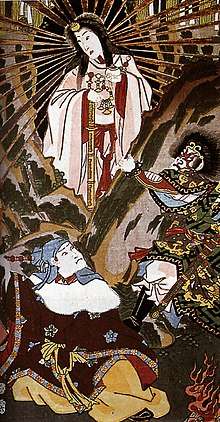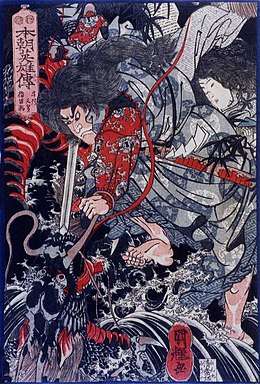Oni
Oni (

They are popular characters in Japanese art, literature, and theatre,[1] and appear as stock villains in the well-known fairytales of Momotaro (Peach Boy), Issun-bōshi, and Kobutori Jīsan.
Description
Depictions of oni vary widely but usually portray them as hideous, gigantic ogre-like creatures with a single horn or multiple horns emerging from their heads,[2] with sharp claws and wild hair.[3]
They are often depicted wearing tiger-skin loincloths and carrying iron clubs called kanabō (金棒).[2] This image leads to the expression "oni with an iron club" (鬼に金棒, oni-ni-kanabō), that is, to be invincible or undefeatable.[4][5]
Their skin may be any number of colors, but red, blue, and green are particularly common.[6][7] They may sometimes also be depicted as black-skinned, or yellow-skinned.[2]
They may occasionally be depicted with a third eye on their forehead,[2][8] or extra fingers and toes.[8]
Origins
An old etymology for "oni" is that the word derives from on, the on'yomi reading of a character (隠) meaning "to hide or conceal", due to oni having the tendency of "hiding behind things, not wishing to appear". This explanation is found in the 10th century dictionary Wamyōshō, which reveals that the oni at the time had a different meaning, defined as "a soul/spirit of the dead".[9][10]
The character for oni, 鬼 (pinyin: guǐ; Jyutping: gwai2) in Chinese also means a dead or ancestral spirit, and not necessarily an evil specter.[9] Accordingly, Chinese (Taoist) origins for the concept of oni has been proposed by Takahashi Masaaki.[11]
The oni was syncretized with Hindu-Buddhist creatures such as the man-devouring yaksha and the rakshasa, and became the oni who tormented sinners as wardens of Jigoku (Hell),[12] administering sentences passed down by Hell's magistrate, King Yama (Enma Daiō).[6] The hungry ghosts called gaki (餓鬼) has also been sometimes considered a type of oni (the letter "ki" 鬼 is also read "oni").[6][10] Accordingly, a wicked soul beyond rehabilitation transforms into an oni after death. Only the very worst people turn into oni while alive, and these are the oni causing troubles among humans as presented in folk tales.[13]
Some scholars have even argued that the oni was entirely a concept of Buddhist mythology.[14]
Demon gate


According to Chinese Taoism and esoteric Onmyōdō, the ways of yin and yang, the northeasterly direction is termed the kimon (鬼門, "demon gate") and considered an unlucky direction through which evil spirits passed. Based on the assignment of the twelve zodiac animals to the cardinal directions, the kimon was also known as the ushitora (丑寅), or "Ox Tiger" direction. One theory is that the oni's bovine horns and tiger-skin loincloth developed as a visual depiction of this term.[15][16][17]
Temples are often built facing that direction, for example, Enryaku-ji was deliberately built on Mount Hiei which was in the kimon (northeasterly) direction from Kyoto in order to guard the capital, and similarly Kan'ei-ji was built towards that direction from Edo Castle.[18][19]
However, skeptics doubt this could have been the initial design of Enryaku-ji temple, since the temple was founded in 788, six years before Kyoto even existed as a capital, and if the ruling class were so feng shui-minded, the subsequent northeasterly move of the capital from Nagaoka-kyō to Kyoto would have certainly been taboo.[20]
Japanese buildings may sometimes have L-shaped indentations at the northeast to ward against oni. For example, the walls surrounding the Kyoto Imperial Palace have notched corners in that direction.[21]
Traditional culture
The traditional bean-throwing custom to drive out oni is practiced during Setsubun festival in February. It involves people casting roasted soybeans indoors or out of their homes and shouting "Oni wa soto! Fuku wa uchi!" ("鬼は外!福は内!", "Oni go out! Blessings come in!").[22][23] This custom has grown from the medieval ritual of tsuina (Chinese: nuo) or oni-yarai, an year-end rite to drive away oni (ghosts).[22][24]
Regionally around Tottori Prefecture during this season, a charm made of holly leaves and dried sardine heads are used as guard against oni.[24][25]
There is also a well-known game in Japan called oni gokko (鬼ごっこ), which is the same as the game of tag that children in the Western world play. The player who is "it" is instead called the "oni".[26][27]
Oni are featured in Japanese children's stories such as Momotaro (Peach Boy), Issun-bōshi, and Kobutori Jīsan.
Modern times
In more recent times, oni have lost some of their original wickedness and sometimes take on a more protective function. Men in oni costumes often lead Japanese parades to dispel any bad luck, for example.
Japanese buildings sometimes include oni-faced roof tiles called onigawara (鬼瓦), which are thought to ward away bad luck, much like gargoyles in Western tradition.[28]
Many Japanese idioms and proverbs also make reference to oni. For example, the expression oya ni ninu ko wa oni no ko (親に似ぬ子は鬼の子) means literally "a child that does not resemble its parents is the child of an oni", and may be used by a parent to chastise a misbehaving child.[5]
See also
References
- Citations
- Lim, Shirley; Ling, Amy (1992). Reading the literatures of Asian America. Temole University Press. p. 242. ISBN 978-0-87722-935-3.
- Reider (2003), p. 135.
- Mack, Carol; Mack, Dinah (1998). A Field Guide to Demons, Fairies, Fallen Angels, and Other Subversive Spirits. Arcade Publishing. p. 116. ISBN 978-1-55970-447-2.
- Jones, David E. (2002). Evil in Our Midst: A Chilling Glimpse of Our Most Feared and Frightening Demons. Square One Publishers. p. 168. ISBN 978-0-7570-0009-6.
- Buchanan, Daniel Crump (1965). Japanese Proverbs and Sayings. University of Oklahoma Press. p. 136. ISBN 978-0-8061-1082-0.
- Hackin, J.; Couchoud, Paul Louis (2005). Asiatic Mythology 1932. Kessinger Publishing. p. 443. ISBN 978-1-4179-7695-9.
- Turne, Patricia; Coulter, Charles Russell (2000). Dictionary of ancient deities. Oxford University Press. p. 363. ISBN 978-0-19-514504-5.
- Bush, Laurence C. (2001). Asian horror encyclopedia: Asian horror culture in literature, manga and folklore. Writers Club Press. p. 141. ISBN 978-0-595-20181-5.
- Reider (2003), pp. 134–135.
- Kuki, Shūzō (2004). Kuki Shuzo: A Philosopher's Poetry and Poetics. Michale F. Marra (tr.). University of Hawaii Press. p. 218. ISBN 978-0824827557.
- Takahashi (1972) Shutendoji no tanjo: mou hitotsu no Nihon bunka 酒呑童子の誕生: もうひとつの日本文化, p. 41, cited in Reider (2003), p. 135
- Reider (2016), pp. 10–11, Reider (2016), p. 137
- Leslie Ormandy The Morals of Monster Stories: Essays on Children's Picture Book Messages McFarland, 7 Aug 2017 ISBN 9781476627694 p. 94
- Anesaki & Ferguson (1928), The Mythology of all Races, p. 280, cited by Reider (2003), p. 314
- Hastings, James (2003). Encyclopedia of Religion and Ethics. Part 8. Kessinger Publishing. p. 611. ISBN 978-0-7661-3678-6.
- Reider (2010), p. 7.
- Foster (2015), p. 119.
- Havens, Norman; Inoue, Nobutaka (2006). "Konjin". An Encyclopedia of Shinto (Shinto Jiten): Kami. Institute for Japanese Culture and Classics Kokugakuin University. p. 98. ISBN 9784905853084.
- Frédéric, Louis (2002). "Kan'ei-ji". Japan Encyclopedia. President and Fellows of Harvard College. p. 468. ISBN 978-0-674-00770-3.
- Huang Yung-jing 黄永融 (1993), master's thesis, "Fūsui shisō ni okeru gensokusei kara mita Heiankyō wo chūshin to suru Nihon kodai kyūto keikaku no bunseki 風水思想における原則性から見た平安京を中心とする日本古代宮都計画の分析", Kyoto Prefectural University, The Graduate School of Human Life Science. Cited by Yamada, Yasuhiko (1994). Hōi to Fūdo 方位と風土. Kokin Shoin. p. 201.
- Parry, Richard Lloyd (1999). Tokyo, Kyoto & ancient Nara. Cadogan Guides. p. 246.: "the walls of the Imperial Palace have a notch in their top-right hand corner to confuse the evil spirits".
- Foster (2015), p. 125.
- Sosnoski, Daniel (1966). Introduction to Japanese culture. Charles E. Tuttle Publishing. p. 9. ISBN 978-0-8048-2056-1.
- Hearn, Lafcadio (1910). Glimpses of Unfamiliar Japan: First and second series. Tauchnitz. p. 296.
- Ema, Tsutomu. Ema Tsutomu zenshū. 8. p. 412.
- Chong, Ilyoung (2002). Information Networking: Wired communications and management. Springer-Verlag. p. 41. ISBN 978-3-540-44256-1.
- Reider (2010), pp. 155–156.
- Toyozaki, Yōko (2007). Nihon no ishokujū marugoto jiten 「日本の衣食住」まるごと事典. IBC Publishing. p. 21. ISBN 978-4-89684-640-9.
- Bibliography
- Foster, Michael Dylan (2015). The Book of Yokai: Mysterious Creatures of Japanese Folklore. Univ of California Press. ISBN 978-0520959125.CS1 maint: ref=harv (link)
- Mizuki, Shigeru (2003). Mujara 3: Kinki-hen. Japan: Soft Garage. p. 29. ISBN 978-4861330063.
- Reider, Noriko T. (2003), "Transformation of the Oni: From the Frightening and Diabolical to the Cute and Sexy", Asian Folklore Studies, 62 (1): 133–157CS1 maint: ref=harv (link)
- Reider, Noriko T. (2010). Japanese Demon Lore: Oni from Ancient Times to the Present. Utah State University Press. ISBN 978-0874217933.CS1 maint: ref=harv (link)
- Reider, Noriko T. (2016). Seven Demon Stories from Medieval Japan. University Press of Colorado. ISBN 978-1607324904.CS1 maint: ref=harv (link)
- Shiryōshitsu Oni Kan
External links
| Wikimedia Commons has media related to Oni. |


